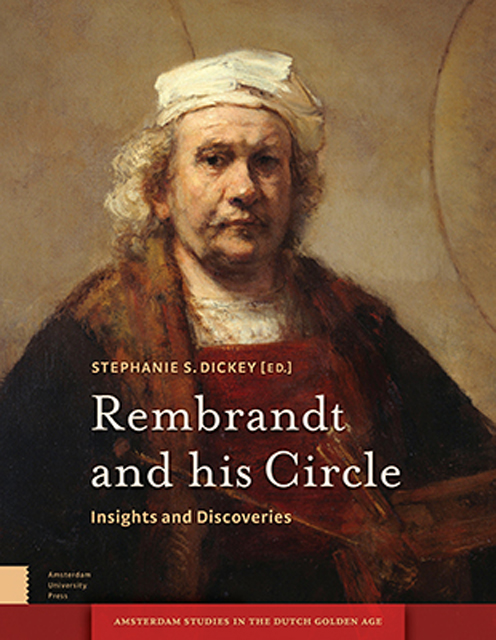Book contents
- Frontmatter
- Dedication
- Contents
- Acknowledgements
- Introduction
- 1 Rembrandt and Frans Hals Painting in the Workshop of Hendrick Uylenburgh
- 2 Rembrandt and the Germanic Style
- 3 Rembrandt and the Humanist Ideal of the Universal Painter
- 4 Curiosity and Desire: Rembrandt’s Collection as Historiographic Barometer
- 5 Painted Landscapes by Lievens and Rembrandt : The View from Seventeenth-Century Amsterdam Collections
- 6 Jan Lievens in Antwerp: Three Rediscovered Works
- 7 Gerrit Dou as a Pupil of Rembrandt
- 8 A New Painting by Jan van Noordt in Budapest
- 9 Rembrandt’s First Nude? The Recent Analysis of Susanna and the Elders from Rembrandt’s Workshop
- 10 Rembrandt’s Head of Christ: Some Technical Observations concerning Matters of Style
- 11 A Rediscovered Head of John the Baptist on a Platter from Rembrandt’s Studio
- 12 Rembrandt’s One Guilder Print: Value and Invention in ‘the most beautiful [print] that ever came from the burin of this Master’
- 13 Rembrandt, Ferdinand Bol, and Tobit: The Emergence of a Pathosträger
- 14 Biblical Iconography in the Graphic Work of Rembrandt’s Circle
- 15 Jan van Vliet and Rembrandt van Rijn: Their Collaboration Reassessed
- 16 Printmaking among Artists of the Rembrandt School
- 17 Chain Line Pattern Matching and Rembrandt’s Prints
- List of Illustrations
- Bibliography
- Index Nominum
8 - A New Painting by Jan van Noordt in Budapest
Published online by Cambridge University Press: 21 January 2023
- Frontmatter
- Dedication
- Contents
- Acknowledgements
- Introduction
- 1 Rembrandt and Frans Hals Painting in the Workshop of Hendrick Uylenburgh
- 2 Rembrandt and the Germanic Style
- 3 Rembrandt and the Humanist Ideal of the Universal Painter
- 4 Curiosity and Desire: Rembrandt’s Collection as Historiographic Barometer
- 5 Painted Landscapes by Lievens and Rembrandt : The View from Seventeenth-Century Amsterdam Collections
- 6 Jan Lievens in Antwerp: Three Rediscovered Works
- 7 Gerrit Dou as a Pupil of Rembrandt
- 8 A New Painting by Jan van Noordt in Budapest
- 9 Rembrandt’s First Nude? The Recent Analysis of Susanna and the Elders from Rembrandt’s Workshop
- 10 Rembrandt’s Head of Christ: Some Technical Observations concerning Matters of Style
- 11 A Rediscovered Head of John the Baptist on a Platter from Rembrandt’s Studio
- 12 Rembrandt’s One Guilder Print: Value and Invention in ‘the most beautiful [print] that ever came from the burin of this Master’
- 13 Rembrandt, Ferdinand Bol, and Tobit: The Emergence of a Pathosträger
- 14 Biblical Iconography in the Graphic Work of Rembrandt’s Circle
- 15 Jan van Vliet and Rembrandt van Rijn: Their Collaboration Reassessed
- 16 Printmaking among Artists of the Rembrandt School
- 17 Chain Line Pattern Matching and Rembrandt’s Prints
- List of Illustrations
- Bibliography
- Index Nominum
Summary
Abstract
Bathsheba at the Deathbed of King David is the subject of a painting in a Hungarian private collection here attributed to Jan van Noordt and placed in the master's early period. The attribution is based on stylistic comparison with works by Van Noordt such as Granida and Daifilo (c. 1645, Sydney, Art Gallery of New South Wales), and the painting is examined in relation to other depictions of this biblical scene by artists in the circle of Rembrandt. This demonstrates the influence of Gerbrand van den Eeckhout's treatment of the same subject (Prague, Národní Galerie) and other sources.
Keywords: Jan van Noordt, Gerbrand van den Eeckhout, Rembrandt van Rijn, Bathsheba, David
It takes a certain courage nowadays to attribute a painting to Jan van Noordt. The monograph by David de Witt, which was published in 2007, really ‘set things straight’ in the oeuvre of the master, with a list of identified works that has expanded spectacularly in the past few decades. On the one hand, it facilitates orientation amid the multitude of paintings done in a congenial spirit and similar style; on the other, it forewarns about attribution based purely on formal criteria. Nevertheless, in this case I have applied a purely style-critical approach after ‘recognizing’ the hand of the master, since I was unable to unearth any tangible proof, such as an entry in an inventory or data from an earlier auction that would support my theory.
The work under consideration here, an oil painting on canvas measuring 112 × 135 cm, was on loan from 2011 to 2015 at the Szepműveszeti Múzeum from a private collection in Budapest. It first appeared in Hungarian private ownership in 2001 (fig. 8.1 and pl. 8.1). In 2011 it was put up for auction at Nagyházi Gallery in Budapest with an attribution to Aert Jansz van Marienhof based on expertise provided by István Németh. Thanks to this expertise the subject of the painting was identified as Bathsheba at the Deathbed of King David (1 Kings 1: 15-31). As to the problem of authorship, Németh emphasised the combination of various stylistic influences: besides Rembrandtesque elements, Nemeth thought he detected features related to the Utrecht school. He cited as a comparison the 1649 painting by Van Marienhof in Dresden.
- Type
- Chapter
- Information
- Rembrandt and his CircleInsights and Discoveries, pp. 189 - 196Publisher: Amsterdam University PressPrint publication year: 2017



